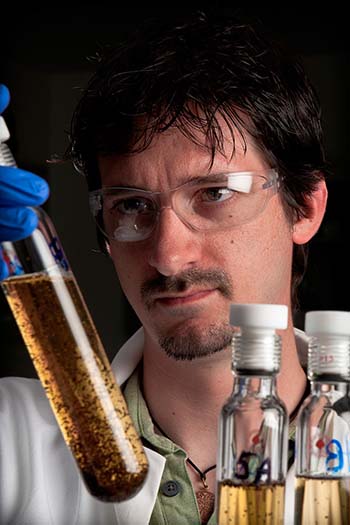
Justin Sluiter
Researcher IV-Chemistry
Justin.Sluiter@nrel.gov
303-384-6347
 https://orcid.org/0000-0003-4170-1383
https://orcid.org/0000-0003-4170-1383
Research Interests
Justin B. Sluiter started at the National Renewable Energy Laboratory (NREL) in 1996, working on a lignin utilization project aimed at catalytic conversion of lignin into a high-octane fuel additive. He also assisted with developing a metal oxide sensor array that would detect volatile organic compounds for indoor air-quality monitoring. At the end of that project, Sluiter began working on the chemical characterization of biomass for the Biomass Program using NREL's Laboratory Analytical Procedures (LAPs). He has extensive experience in the lab performing the LAPs, and he played a major role in recent LAP revisions. His in-depth knowledge of the LAPs has led to him training all new team personnel as well as performing requested training for industrial partners. As the industry becomes more interested in biomass compositional analysis, Sluiter is responding to hundreds of questions about proper LAP techniques and adaptation to new feedstocks. As a senior member of the team and a recognized biomass analysis expert, Sluiter is responsible for the internal review of data quality for all team technicians. He is also working on LAP method optimization for new feedstocks and for diverse instrumentation.
Biomass compositional analysis data are the primary input to NREL's pretreatment models and techno-economic analyses. As such, all biomass samples (initial feedstock and pretreated intermediate solids and liquids) must first be analyzed for components of interest (primarily carbohydrates, lignin, and extractable materials). Each LAP requires a multitude of steps, equipment, and techniques to be performed successfully.
Sluiter is investigating adaptations to the published methods to increase LAP applicability. The adaptations must be tested to ensure the same quality as previous techniques.
Sluiter is currently investigating the following areas:
-
Starch is present in all plants but is mostly of interest in feedstocks that contain grain. Starch glucan is more labile to acid hydrolysis than cellulosic glucan, which can lead to under-quantification of glucan under typical acid hydrolysis procedures. A more appropriate quantification of glucan that will allow differentiation of starch glucan and cellulosic glucan is under development.
-
Liquid process intermediate samples contain the majority of the xylose and significant levels of other sugars after dilute acid pretreatment of a feedstock. It is important to understand the uncertainties associated with the measurement of these sugars so that appropriate confidence levels may be assigned to subsequent calculations. A study is currently underway to determine these uncertainties.
-
The determination of inorganic material in biomass is important for understanding the potential buffering that such material can have during dilute acid pretreatment. The NREL LAPs make specific recommendations as to the equipment that is used during the determination of inorganic materials. Alternate materials that may provide benefits in time or cost are under consideration.
-
NREL LAPs utilize sugar recovery standards (SRSs) to account for the degradation of sugars during compositional acid hydrolysis. For SRSs to perform optimally, the SRS sugar concentrations must approximate the corresponding sugar concentrations in the sample. Methods for optimizing efficiency and ensuring representative SRSs are under investigation.
-
Learn more about NREL's Biomass Compositional Analysis Laboratory.
Education
-
B.S., Mathematics, Regis University, 1994–1998
-
B.S., Chemistry, Regis University, 1994–1998
Professional Experience
-
NREL, 1996–present
Featured Publications
-
"Compositional Analysis of Lignocellulosic Feedstocks. 1. Review and Description of Methods," J. Agric. Food Chem. (2010)
-
"Compositional Analysis of Lignocellulosic Feedstocks. 2. Method Uncertainties," J. Agric. Food Chem. (2010)
-
"Metal oxide sensor arrays for the detection, differentiation, and quantification of volatile organic compounds at sub-parts-per-million concentration levels," Sensors and Actuators B: Chemical (2006)
-
"Calibration Transfer Among Sensor Arrays Designed for Monitoring Volatile Organic Compounds in Indoor Air Quality," IEEE Sensors Journal (2006)
Laboratory Analytical Procedures
-
Summative Mass Closure: Laboratory Analytical Procedure Review and Integration: Feedstocks, NREL Technical Report (2011)
-
Preparation of Samples for Compositional Analysis, NREL Technical Report (2008)
-
Determination of Extractives in Biomass, NREL Technical Report (2008)
-
Determination of Structural Carbohydrates and Lignin in Biomass, NREL Technical Report (2008)
-
Determination of Total Solids in Biomass and Total Dissolved Solids in Liquid Process Samples, NREL Technical Report (2008)
-
Determination of Sugars, Byproducts, and Degradation Products in Liquid Fraction Process Samples, NREL Technical Report (2006)
-
Determination of Ash in Biomass, NREL Technical Report (2005)
View all NREL Publications for Justin B. Sluiter.
Share
